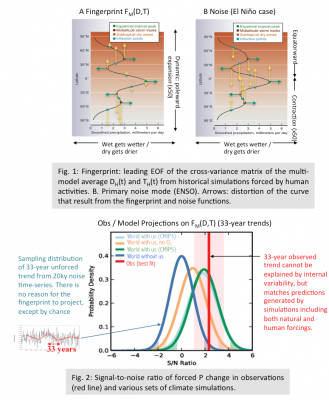Natural and Human Influences on Changing Zonal-Mean Precipitation
Anthropogenic increases in greenhouse gases and stratospheric ozone depletion are expected to lead to a latitudinal intensification and redistribution of global precipitation. Detecting these mechanisms in the observational record is complicated by strong climate noise and model errors.
- We define indicators of thermodynamic T(t) and dynamic D(t) change at peaks and throughs of zonal average P.
- We calculate from climate simulations the multivariate fingerprint FM(D,T) (expected response to human forcings).
- We project observed and simulated data onto FM(D,T).
- Our technique eliminates strong climate noise and model errors.
Our approach shows, for the first time, that:
- The simultaneous changes global precipitation predicted by theory are detectable in observation.
- These observed changes are unlikely to arise purely from natural climate variability.
- External influences, probably anthropogenic in origin, are responsible.
We are very grateful to Ben Santer and Karl Taylor for helpful comments and infinite patience. This work was supported by the Global Climate Modeling Program of the US Department of Energy (DOE) Office of Science and was performed under the auspices of the US DOE Lawrence Livermore National Laboratory (LLNL) (Contract DE-AC52-07NA27344). K.M. was supported by an LLNL Laboratory Directed Research and Development award (tracking code 13-ERD-032). C.B. was supported by her DOE Early Career Research Program award. We acknowledge the World Climate Research Programme’s Working Group on Coupled Modelling, which is responsible for CMIP, and we thank the climate modeling groups (listed in SI Appendix, Table S2 of this paper) for producing and making available their model output. For CMIP the US DOE’s Program for Climate Model Diagnosis and Intercomparison provides coordinating support and led development of software infrastructure in partnership with the Global Organization for Earth System Science Portals.

